Omnichannel marketing has impacted consumers and businesses, changing how products are marketed online and offline. Consumers now engage with brands through various new touchpoints, but their desire for a connection with a company and their search for value remains the same.
Rather than adopting a one-size-fits-all strategy, marketers must be able to identify their prospects in the marketing funnel along with their frequently used channels to develop a modern marketing strategy. Customers have moved away from the traditional buying journey over time, and marketing leaders must realize where their customers spend their time.
Marketers must also consider customers’ needs when developing a modern marketing strategy. This blog explores the significance of omnichannel marketing and how a marketing team might implement and utilize an omnichannel marketing approach.
What is omnichannel marketing?
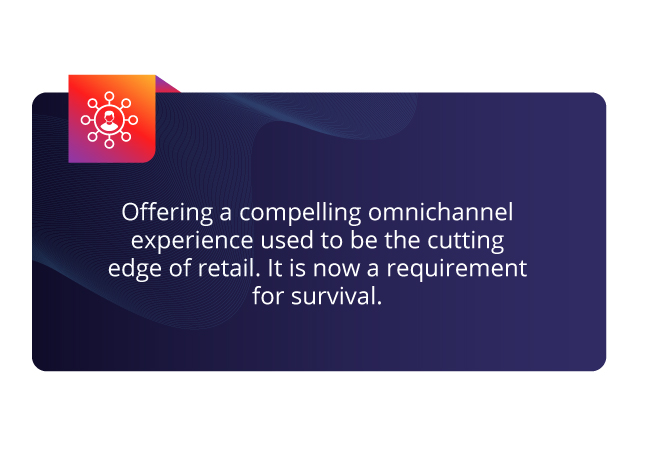
Mckinsey states, “Offering a compelling omnichannel experience used to be the cutting edge of retail. It is now a requirement for survival.“
To understand omnichannel marketing and how to implement an omnichannel experience, we must define the word “Omnichannel.” According to Gartner, it refers to the seamless integration of digital and physical assets, most commonly in retail.
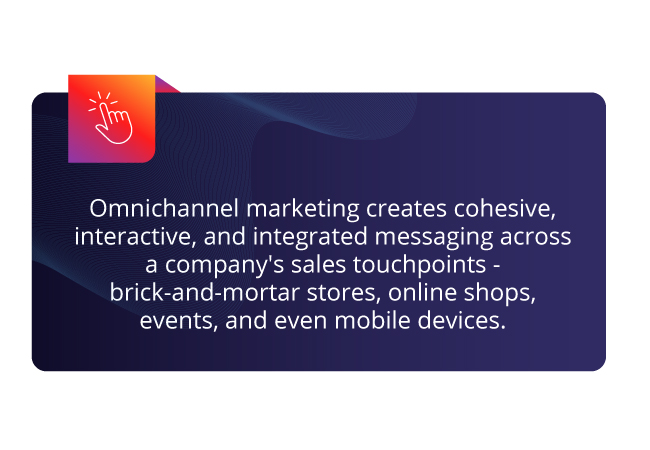
The goal of omnichannel marketing is to create a consistent user experience across all channels relevant to the buyer’s journey. It also refers to a change in how people move through the marketing funnel.
Marketers typically use an advanced customer engagement platform to strategize, monitor, and perform marketing automation while developing a sense of consistency when a shopper encounters a brand across different marketing channels during their customer journey.
A customer, for example, may come across a dress on a brand’s social page, which leads them to their online store, where they browse other items. While doing so, the customer receives an email or a message via multiple or single channels with a reward/discount code that encourages them to purchase.
After purchasing, they may receive discounts and loyalty points redeemable in offline stores. This may appear relatable to us, but it is an excellent example of an omnichannel marketing strategy.
As technology advances and becomes more integrated into our daily lives, the distinctions between offline and online become increasingly blurred. The same Mckinsey study states, “Younger buyers are the most excited about new shopping experiences.”
Most Gen Z consumers are increasingly judging online and offline brands and retailers on the consistency of their shopping experience throughout the customer journey.
As a result, marketers must understand why omnichannel marketing is essential and how developing an omnichannel marketing strategy adds value, especially if they want to increase ROI and engagement with their potential and existing customers.
Now that we’ve seen how technology and omnichannel marketing strategies can significantly improve your essential marketing KPIs let’s embark on a historical journey.
Let’s learn about the evolution of omnichannel marketing and how specific omnichannel marketing trends were leveraged by marketers worldwide.
Evolution of omnichannel marketing strategies and trends
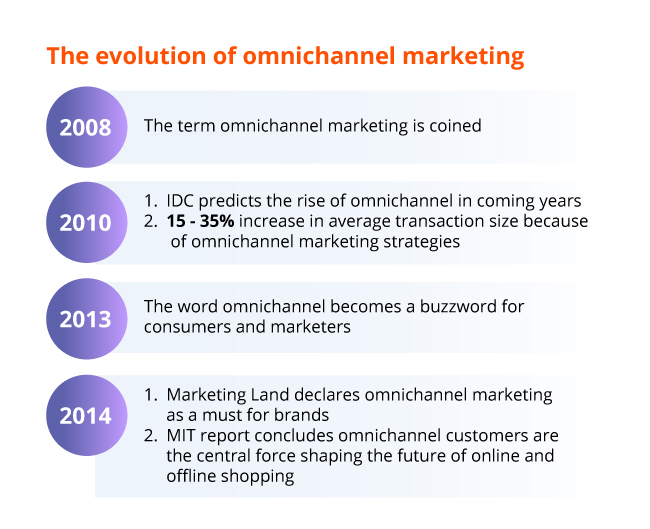
IDC’s coveted retail insights report, published in 2010, predicted that successful marketers would rely heavily on omnichannel in the coming years. This was the first time a significant market intelligence provider discussed the advantages of cross-industry omnichannel marketing.
The report examined omnichannel marketing strategies. In the report, IDC analysts discovered a 15-35% increase in average transaction size and a 5-10% increase in loyal customers’ profitability. According to IDC, the growing ecommerce market was the primary reason retailers needed to adopt an omnichannel mindset.
In 2013, the term “omnichannel” became popular among marketers and customers. Marketing Land (now known as MarTech.org), the gold standard of marketing publication companies, declared omnichannel a “must” for brands and retailers in early 2014. According to an MIT report, omnichannel customers are the “central force shaping the future of ecommerce and brick-and-mortar stores.”
Like IDC and Huffington Post, Marketing Land attributes the rise of omnichannel marketing to the digital age. According to the MIT report, mobile and social media accounted for $12 billion in retail sales, while the web influenced $1.1 trillion in in-store sales. These findings suggest that customers use multiple channels to ensure a seamless shopping experience throughout their journey.
Now that we understand how omnichannel marketing came to be, let’s delve into some of the requirements for creating effective marketing campaigns and embrace the power of harnessing an omnichannel mindset.
How to build the right mindset for an omnichannel marketing strategy?
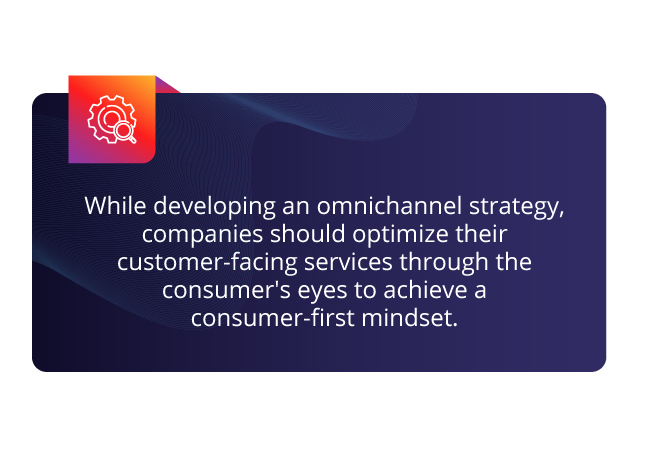
To truly develop an omnichannel mindset, the company must understand how to make its products perform and where they must perform (which channel). Businesses must step back from day-to-day bottom-line monitoring activities to assess the customer experience and provide excellent customer service.
A consumer-first experience should include the following elements:
Boundless and seamless: Brands must effectively engage with customers across all channels. Marketers must continue sharing their messaging once a sale is made. Instead, they must think about retention, which is only possible if they cater to the customer’s needs continuously and effortlessly.
Customized: Today’s consumers expect hyper-personalized media-heavy content, customized messaging, and a high level of empathy from businesses across all platforms. Companies must treat each customer differently; doing so gives the impression that brands constantly think about them as individuals rather than as a mass audience.
Communicative: Customers today want to have meaningful conversations with brands, share feedback, and become loyal customers by looking for value in their purchases. Companies could provide a seamless customer experience that addresses their concerns and conveys a sense of sincerity while empowering customers at the same time.
Now that we’ve built the right mentality for embracing omnichannel marketing strategies let’s see why omnichannel marketing is essential.
Why is omnichannel marketing important?
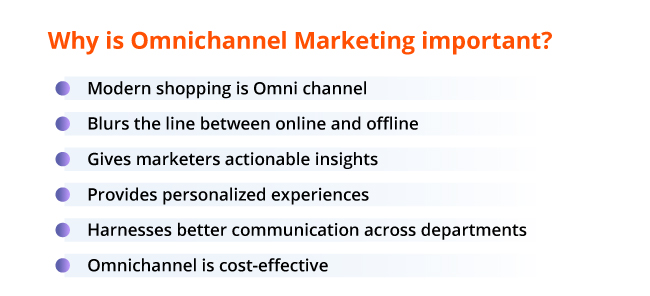
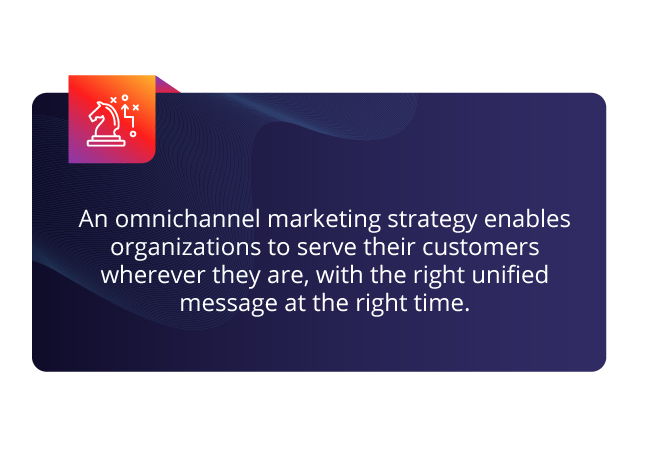
Here are a few reasons why going Omni channel is critical for marketers and businesses worldwide:
1. Modern shopping is omnichannel
Consumers can make online purchases anytime, thanks to technological advances. For example, customers can purchase products by communicating with their smart home devices while doing day-to-day chores.
According to one report, the average person in North America use almost 14 devices. Thus, having a brand presence across multiple channels is critical to developing an omnichannel marketing strategy.
2. Blurs the line between online and offline
Omnichannel marketing provides customers with a consistent brand experience across online and offline physical stores. Marketers can promote their products and attach a reward system only available through specific channels like brick-and-mortar stores. This capitalizes on the users’ desire for value while being present across multiple channels. It also results in increased sales and customer satisfaction.
3. Gives marketers actionable insights
The days of manually analyzing a single channel’s performance are long gone. Omnichannel marketing campaigns primarily use advanced data and analytics tools, which provide marketers with a 360-degree view of campaign performance and user activity. With these tools, marketers create and modify highly interactive marketing campaigns that increase sales.
4. Provides personalized experiences
Throughout the customer journey, 90% of consumers find messages from companies that are not personally relevant to them ‘annoying.’ Marketers must scale personalization with omnichannel marketing strategies. They must seamlessly distribute relevant content to improve customer engagement across multiple channels.
5. Harnesses better communication across departments
Traditionally, businesses’ marketing functions have operated in silos. Companies need help in sharing critical information across departments. Communication through an omnichannel approach fosters a sense of unity across verticals and departments as information is shared systematically. This also improves the organization’s operational efficiency.
6. Omnichannel is cost-effective
Implementing an omnichannel marketing strategy correctly is data-driven, taking the guesswork out of your content placement strategies. Acquiring a new customer costs more than retaining an existing one. Marketers can continue meaningful conversations with their existing customers through the most used channels—this aids in the retention of current customers as well as increases brand advocacy in the long term.
According to Nicholas Einstein, a thought leader and VP of Product Marketing at Netcore, tailored messaging is essential for consumers and marketers.
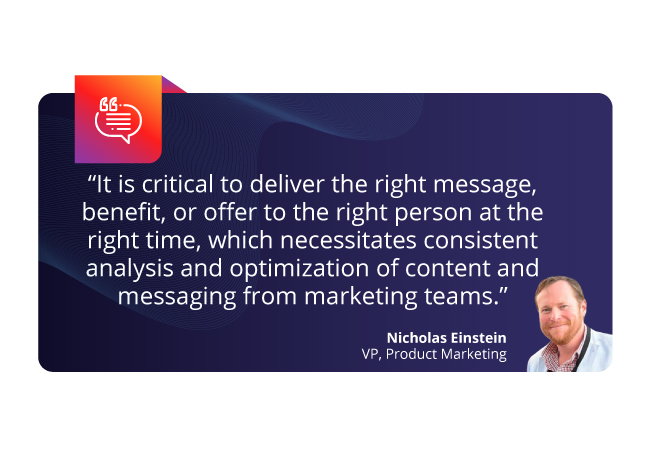
Now, let’s use a real-world example to investigate why businesses must adopt omnichannel marketing.
Omnichannel marketing examples in the real world
Given below are some omnichannel marketing examples top brands have executed:
Crocs achieved 42X ROI with effective customer engagement and a personalization suite.
Crocs is a distinctive clog brand that gained enormous popularity among consumers in the early 2000s. The apparel brand has a presence in over 40 countries and offers over 120 styles for men, women, and children. The brand represents innovation, fun, and comfort for people who want shoes that fit their personalities, lifestyles, and feet.
The challenges:
- Customers would add items to their cart while browsing and leave the website without completing online purchases – because of ineffective customer engagement. Sales dropped. Revenues decreased.
- Crocs is a brand with thousands of iterations but they couldn’t provide relevant recommendations to their customers because they lacked the infrastructure needed to analyze product data across multiple SKUs and stocks.
- Teams needed help providing consistent messaging across channels throughout the customer journey. They needed to show customers the right products, messages, offers, and engagements at the right touchpoints.
- All of these factors impacted customer retention because customers simply did not return to the platform due to previous negative experiences, lowering customer lifetime value.
How Netcore Cloud’s AI-based Customer Engagement Platform and Personalization suite helped Crocs:
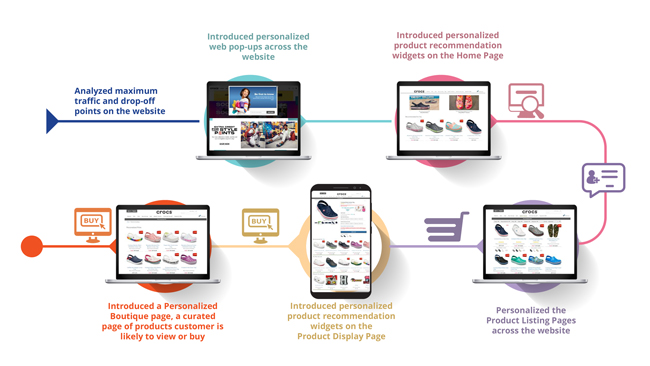
Learn the omnichannel marketing strategy that helped Crocs drive impressive 42x ROI with Netcore’s customer engagement platform
Before we grasp the essential ingredients of crafting an effective omnichannel marketing strategy, here’s an interesting study.
Did you know?
Harvard Business Review conducted a 14-month study to understand customers’ shopping behavior.
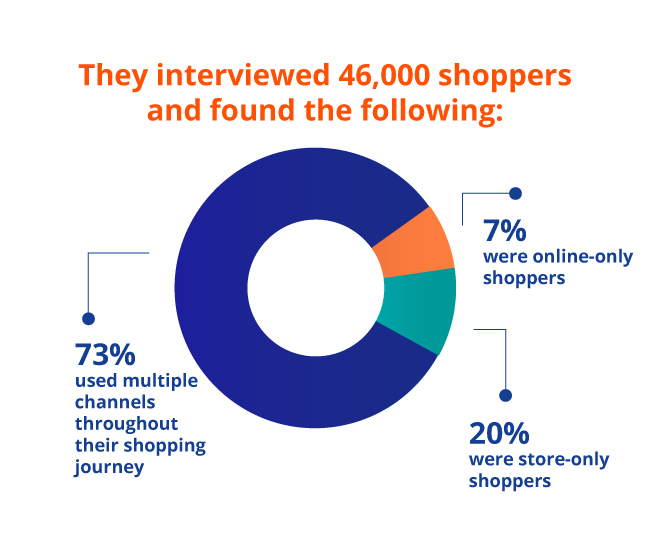
Customers who used more than four channels spent 9% more than those who used a single channel.
Walgreens Omnichannel Marketing Prescription for Success
Tim McCauley, Sr. Director of Mobile Commerce at Walgreens, reports that omnichannel customers spend 3.5-6 times more than those who shop only in-store. Adam Pellegrini, Vice President of Digital Health at Walgreens, terms this a “connected health strategy.”
This strategy ensures a seamless customer experience across digital and physical platforms, allowing customers to move effortlessly between online, mobile, and in-store interactions.
Customers can manage their health digitally—whether refilling prescriptions, receiving virtual doctor consultations through Walgreens’ partnership with MDLive, or participating in digital health coaching with WebMD—and continue the process in-store if needed.
Walgreens also leverages omnichannel marketing strategies like digital photo printing services available via app or in-store and geofencing-enabled loyalty programs that notify customers of rewards when they’re near a store.
Additionally, they also included fitness rewards that allow customers to earn points for physical activity tracked by devices like Fitbit. Walgreens’ omnichannel marketing strategy exemplifies how integrating digital and physical experiences not only enhances customer convenience but also drives engagement and loyalty.
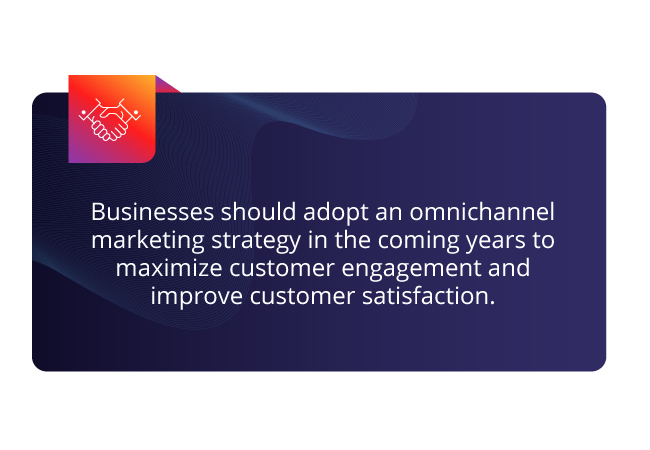
How to create an omnichannel marketing strategy?
1. Collect and analyze customer data
It’s essential to understand your target audience so you can craft an effective omnichannel marketing strategy. Marketers must examine their customers’ behavioral and transactional data to understand their needs, objectives, and preferences and thereby identify ideal customers through personas.
Marketers can also collect customer feedback at various life cycle stages through podcasts, quizzes, and other means. Marketing teams can use this information to analyze their feedback, improve their offerings, and improve the overall customer experience – online and offline.
Did you know?
A Customer Data Platform (CDP) can help!
A CDP collects and unifies first-party customer data from multiple sources to build a coherent, complete view of each customer. It then makes that data available to marketers to create targeted and personalized customer experiences.
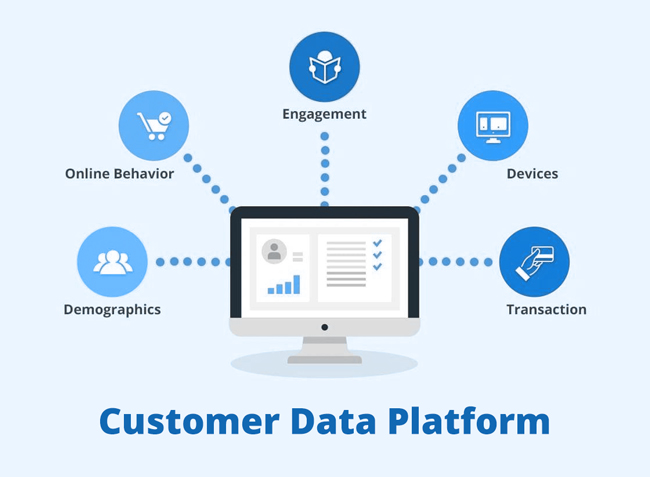
2. Share customer data across departments
Data is only powerful when marketing teams can leverage it to develop strategic customer insights. Data-driven marketing teams use customer data to tackle problems around customer experience. Here is how sharing data across departments positively affects organizational functions in an omnichannel approach:
Sales – Team members can identify customer pain points, help deliver solutions across the customer journey, and improve their experience.
Marketing – Team members can create and develop highly personalized messaging across channels for better engagement.
Product or Service – Teams can understand the customer’s need to modify and alter products and services accordingly.
Hence, placing your customer data in the middle of your organization’s omnichannel approach enables an excellent customer experience, removes data silos between business functions and helps foster fruitful communication.
3. Create effective segmentation of your audience
The essence of omnichannel marketing is targeting your audience with highly personalized messaging. Audience segmentation is the most effective way to deliver a highly targeted omnichannel campaign.
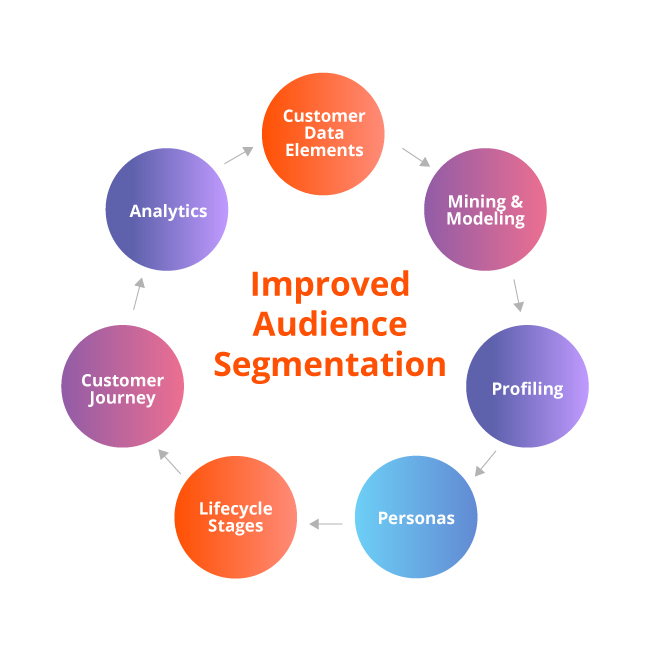
An omnichannel strategy like audience segmentation could effectively be based on these three broad characteristics:
Purchase habits: Check their shopping frequency. When was the last time they bought from a brand? Where are they currently located in the customer journey?
Customer information: Their demographics, age, location, gender, preferences, and other information you’ve gathered over time.
Methods of participation: Which channels, devices, and platforms do they use to interact with your brand?
Marketers can now set up marketing automation that triggers messages when a customer performs a specific action based on segmentation. Marketers can also target different channels. This will enable customers to receive the appropriate message at any point along their journey, an essential aspect of omnichannel marketing strategies.
Did you know?
Personally Identifiable Information (PII) is any data that can identify a specific individual. It’s what distinguishes one person from another and can be used for the de-anonymization of aggregate data.
Examples: First and Last name, Phone number, Email Address, Mobile number, and Social Security number. Leverage PII. It will help your marketing teams develop highly focused segmentation schemes.
4. Create a seamless app and website experience
The modern customer uses smartphones and tablets increasingly to consume content and interact with brands, so the incidents must be seamless and engaging. In this era, customers don’t want to interact with websites and apps that increase wait time while loading. This leads to an attention recession.
Marketing leaders must employ the best User Experience (UX) practitioners, engineers, and writers to communicate their brand messaging and display it in a snappy and snackable format on the app and website. All platforms and mediums require designs that flow naturally. A typical customer needs more time to figure out an app’s navigation via trial and error.
5. Develop consistent value-adding content
Marketers should be aware of the power of content. Create relatable content and conversations. It improves marketing performance. Once an effective relationship is established between a brand and a customer, marketers can strive towards repurchases and advocacy. Marketers must also provide a reason to return by creating case studies and use cases. Include feedback and reviews from customers. Send out notifications and updates about changes and exciting plans that boost sales.
The fact is marketing and brand leaders don’t have to start big and integrate all the channels at once. Marketers can start small by incorporating a few channels and comparing the results with previous marketing campaigns.
Even 2 or 3 channels working together can increase the purchase rate by 287% in the case of an omnichannel marketing campaign.
Let’s now move away from the data and the methods and address one of the critical dilemmas marketers face today.
Omnichannel vs multichannel marketing: What is the difference?
Multichannel and omnichannel marketing sound similar, but they are distinct and serve distinct functions. One has a more significant impact than the other. Let’s see how it goes.
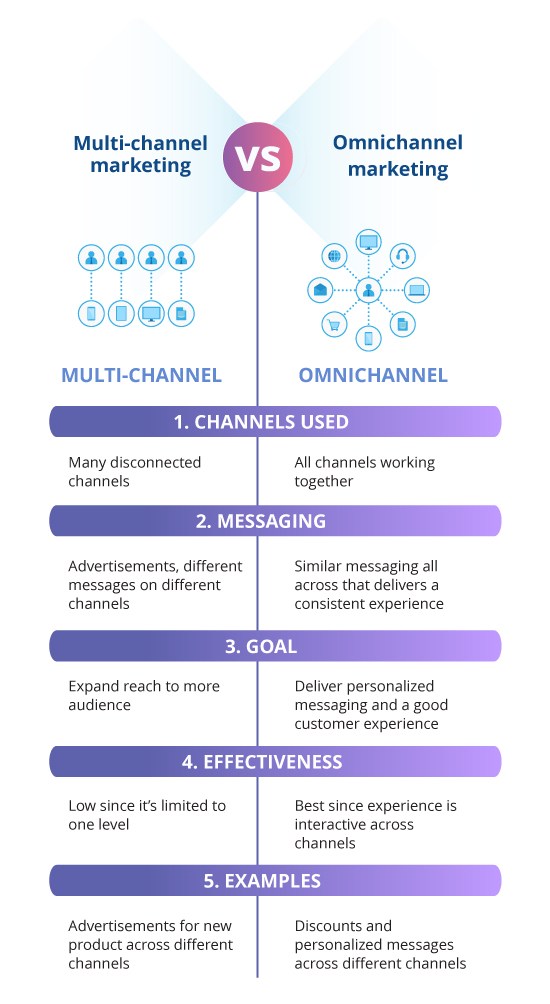
Now that we have understood the critical differences between omnichannel vs multichannel marketing and have absorbed the same’s fundamental essence, let’s answer the following important question:
How does omnichannel marketing affect a business’s bottom line?
According to Analytic Partners’ latest ROI Genome report, Omnichannel and a Brave New World: Companies that embrace an omnichannel marketing strategy increase ROI by 32% compared to those that do not.
Omnichannel marketing can boost your ROI owing to the following:
a. Consistent messaging: It entails, first and foremost, personalizing content at each stage of the user journey and adequately training staff to address customers’ needs.
b. Continuous communication: Continuity across all channels ensures your prospects are led in the right direction at various brand touchpoints.
c. Consistent experience: A consistent experience throughout the buyer’s journey increases the customer’s lifetime value. To accomplish this, train employees to respond consistently to how customers interact with your brand.
As a result, because omnichannel marketing encourages customer interaction across multiple touchpoints and media, increased engagement at each stage of the buyer’s journey leads to increased revenue.
Highly targeted messaging also improves customer loyalty, which leads to more purchases over time. Once the above traits are mastered, omnichannel marketing can deliver exponential results, especially for retail brands, like it increased ROI by 4x for Crocs.
Did you know?
A combined digital and physical presence can help brands drive increased impact by more than 30%. Brands measuring only a single channel are in danger of underreporting ROIs by roughly half.
Conclusion
We established that omnichannel marketing and marketing automation capabilities are the right marketing approaches today. They provide an unparalleled customer experience and make the customer feel deeply understood. Messages, notifications, emails, search and social media ads combine promotional sales and content. They enhance the customer experience.
Netcore’s Cloud’s Omnichannel Platform contains the infrastructure and expertise to set up and launch your omnichannel marketing channels and campaigns in a matter of weeks.
Our strength lies in creating diverse customer bases and effectively reaching customers across channels with seamless marketing campaigns and journey orchestration. Learn more about how Netcore can help your brand reach customers with the right message at the right time.













